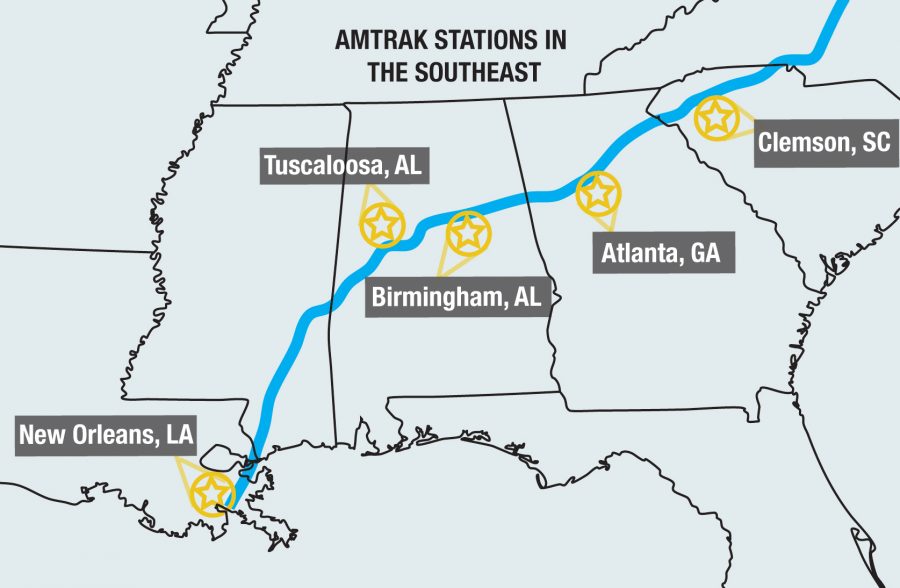 When Diane Salls, president of the Ceres Garden Club of Northport, moved to Tuscaloosa more than 50 years ago, she would pass the Greensboro Avenue train depot and think to herself that a town of Tuscaloosa’s caliber needed a better train station.
When Diane Salls, president of the Ceres Garden Club of Northport, moved to Tuscaloosa more than 50 years ago, she would pass the Greensboro Avenue train depot and think to herself that a town of Tuscaloosa’s caliber needed a better train station.
The problem was the train depot was owned by the Norfolk Southern Corporation, not the City of Tuscaloosa. After decades of driving by the station, Salls decided to take matters into her own hands.
“I wrote letters,” she said. “I got my garden club to write letter after letter after letter until finally we were asked ‘please do not write any more letters.’”
Salls and the Garden Club sent letters up the chain of command until she started hearing back. In 2012, after working with local companies and Norfolk Southern to bring in everything from fresh paint to flower beds to benches to a flagpole, the Tuscaloosa Train Station was re-dedicated in a public ceremony with Mayor Walt Maddox and City Councilman Harrison Taylor in attendance.
“We did what we could. So many of the things we used there were given to us because we’re just a small little garden club,” Salls said. “But we are powerful women that can fight for what we want, and we got out there, and we wrote our letters, and we made our telephone calls, and we went to council meetings.”
(See also “Planes, trains, automobiles: an argument for high-speed rail service“)
Salls heard the call again in March when Joseph Boardman, Amtrak’s president and CEO, stopped by and encouraged citizens to contact their elected officials. Otherwise, a lack of federal funds could threaten to close Tuscaloosa’s Amtrak stop.
Salls said tourism and gameday traffic make the stop an asset to the Tuscaloosa community. She personally uses it to travel with her husband to New Orleans and loves meeting people on the journey.
“We cannot afford to lose our train station,” she said. “We’ve got to fight for them keeping our stop here.”
Councilman Harrison Taylor of District 2, where the station is located, said although the news surrounding Amtrak’s most recent visit implied possible losses, the real story was one of future potential. Amtrak’s president, he said, noted nationwide growth in ridership numbers.
“[The visit] was encouraging,” Taylor said. “Everything sounded positive and looked positive, so we feel positive about it.”
Taylor said the station is important to Tuscaloosa because it creates a first impression for visitors. As a result, he said, parties from the mayor to the citizens are working toward upgrades and development.
“They’re onboard with us. We’re all working together to do what we can do, and we will do something to it to make our citizens pleased with it,” Taylor said. “If we can find the funding, it will be done.”
(See also “Not-so-crazy train“)
Part of that process, he said, could involve purchasing the station to access the federal funds necessary for renovation. The result would be significant for his district, he said.
“We want to be a part of our renovation. My district is in one of the oldest parts of Tuscaloosa. We want to make sure as we go in there and remodel and repair and decorate,” Taylor said. “That’s going to be a big part of our celebration as we finish it up. The train station is back.”
Currently, the Amtrak stop in Tuscaloosa is part of the Crescent Route, which also stops in New Orleans. Sarah Haas, a senior from Bay St. Louis, Miss., took the train home her freshman year, before the station was renovated.
Though she said the station at the time was unsatisfactory, and the limited schedule made it difficult to continuously use it, she said the experience itself was enjoyable.
“A lot of people just don’t know about it. We’re not used to taking trains. We don’t really think about it like you do a plane or a car,” she said.
In fact, she said, the increasing growth of enrollment and vehicles on campus may make the station valuable to the University as well. A telltale sign for how far the station has to go, however, is that few of Haas’ friends even knew there was a station when she told them how she rode the train home.
“I think that if more people knew about it, they’d be more inclined to use it,” she said. “I don’t know how often the citizens of Tuscaloosa use it, but I think the University could do more as marketing for the school to promote that to students as an option. That might actually be kind of a selling point for students.”
(See also “Transportation modes, economic stereotypes“)









